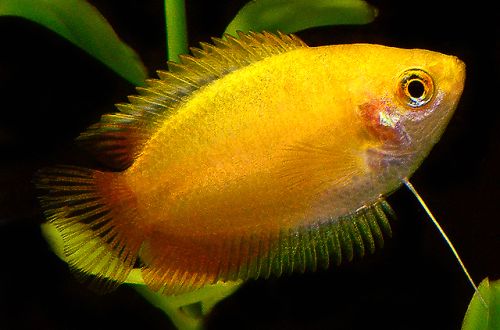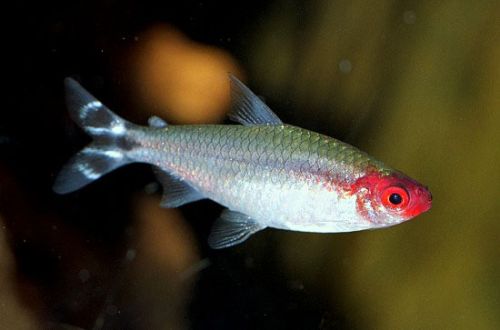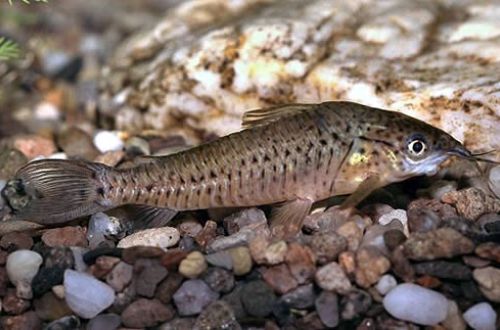
Dugos nga Gourami
The honey gourami, scientific name Trichogaster chuna, belongs to the Osphronemidae family. A small beautiful fish, painted in soft shades of silver gray and light yellow. During spawning, males become a rich honey color, from which they got their name.

When the fish was discovered in 1822, researchers initially mistook the male and female for two different species and gave them separate scientific names accordingly. The error was later corrected, and a close relationship to another related species, Lalius, was also found, but the latter is more popular due to its more flamboyant appearance. Honey Gourami only develops their full color when conditions are favorable, and pet stores tend to be stressful, so they look less presentable.
Kaundan
Habitat
Distributed mainly in the Far East, they inhabit rivers and lakes, ponds, ditches, and flooded fields. Many of these areas experience seasonal fluctuations due to the annual monsoons from June to October. Fish prefer areas with dense vegetation, weak currents or stagnant water. They feed on small invertebrates, insects and other zooplankton.
During feeding, an interesting behavior is observed, Gurami catches its prey, which can even be above the water. Having caught up with the victim, the fish, with a sharp contraction of the oral cavity, gives out a stream of water, selling the insect from a branch, leaf, or during the flight.
Description
Its small size makes it one of the smallest gourami species. Adults barely exceed 5 cm. The shape of the body is similar to Lyalius, but the fins are noticeably smaller. The base color varies from silvery gray to light yellow with a dark horizontal stripe down the middle. During spawning, males become brighter – the anal and caudal fins are painted in rich honey or reddish-orange colors. The abdomen acquires a bluish dark tint.
There are several color forms: red and gold. Both forms are more popular than the original look, due to the vibrant colors that last in all their glory in retail stores.
Food
In the home aquarium, all types of dry industrial food (flakes, granules) are accepted, herbal supplements are recommended. There are specialized foods for Gourami that enhance the color, as well as containing all the necessary vitamins and minerals, including plant substances. Feeding is carried out once or twice a day.
Pagpadayon ug pag-atiman
Not demanding on the conditions of detention, perfectly adapted to the confined space of aquariums. To maintain optimal water quality, install an efficient filtration system and change the water once a week by 25%. Choose a filter with the condition that it does not create strong currents, since the fish prefer a weak current or stagnant water. Other important equipment: aerator, lighting system, heater. The presence of a cover is mandatory, this will avoid splashes during a possible hunt for flying insects, and also minimizes the risk of damage to the labyrinth organ during breathing with atmospheric air. Under the lid, a layer of air is formed with high humidity and a temperature above room temperature.
In decoration, create plenty of caches and hiding places, especially when kept with larger fish. Plants are located in groups next to the shelters or along the side walls. The soil is any dark, it helps to enhance the color.
sosyal nga kinaiya
Peaceful and shy species, takes a long time to adapt to a new aquarium. It can be easily intimidated by active, energetic fish, so give preference to small, calm carp fish as neighbors. They can live both separately and in a group of their own kind, but in the latter case, an internal hierarchy will arise with a dominant individual. Honey Gourami form a pair that lasts for a long time.
Mga kalainan sa sekso
The female retains color throughout her life; in males, on the contrary, it changes during spawning. Colors become saturated, more vivid.
Pagpasanay / pagpasanay
Breeding is quite simple, the fish builds a nest from a foam mass, in the presence of floating leaves, they will become the basis for attaching the future nest. Unlike his relative Lyalius, after spawning, the male is much more tolerant of the female when guarding the clutch.
If in the aquarium, in addition to the male / female pair, there are also fish, then a separate tank will be required for breeding. A volume of 20 liters is enough, the water level is recommended no more than 20 cm, in terms of parameters it should match the main aquarium. Equipment: simple airlift filter, aerator, heater and lighting system. Floating plants with wide leaves are obligatory in the design, the male builds a nest under the leaf, so it turns out to be stronger than just on the surface of the water.
The stimulus for spawning is the addition of meat products to the daily diet, after a while the female will noticeably round up from caviar, and the male will become more colorful. It’s time to transplant the couple into a separate tank. After the nest is built, the courtship ritual begins, the male swims near the female, inviting her to follow him to a new nest, this continues until the female begins to spawn. The female releases several dozen eggs at a time, the male immediately fertilizes them and carefully transfers them to the nest. In total, more than 300 eggs can be laid.
After the end of spawning, the male protects future offspring from everyone, including the female, which should be transplanted back into the common aquarium. The fry appear after 24-36 hours depending on the water temperature, now it is the turn of the male to leave his offspring. After three days, the fry begin to move freely around the tank, they should be fed with special microfeed (sold in pet stores).
Mga sakit
In an aquarium with an established biosystem and the necessary water parameters, there are no health problems. Deterioration of conditions provokes a number of diseases, the most common of which is Velvet Rust. In recent years, a large number of fish infected with various incurable strains of viruses have appeared on the market, the reason lies in the methods of rearing in commercial hatcheries, where hormonal supplements are widely used to enhance color. Before releasing fish into a community tank, they must go through a quarantine period of at least 2 weeks. Read more about symptoms and treatments in the Aquarium Fish Diseases section.





